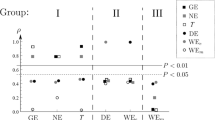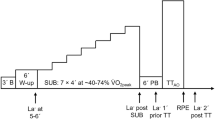Abstract
Reported values of “internal power” (IP) during cycling, generated by the muscles to overcome energy changes of moving body segments, are considerably different for various biomechanical models, reflecting the different criteria for estimation of IP. The present aim was to calculate IP from metabolic variables and to perform a physiological evaluation of five different kinematic models for calculating IP in cycling. Results showed that IP was statistically different between the kinematic models applied. IP based on metabolic variables (IPmet) was 15, 41, and 91 W at 61, 88, and 115 rpm, respectively, being remarkably close to the kinematic estimate of one model (IPWillems-COM: 14, 43, and 95 W) and reasonably close to another kinematic estimate (IPWinter: 8, 29, and 81 W). For all kinematic models there was no significant effect of performing 3-D versus 2-D analyses. IP increased significantly with pedal rate – leg movements accounting for the largest fraction. Further, external power (EP) affected IP significantly such that IP was larger at moderate than at low EP at the majority of the pedal rates applied but on average this difference was only 8%.




Similar content being viewed by others
References
Bland JM, Altman DG (1986) Statistical methods for assessing agreement between two methods of clinical measurement. Lancet 1:307–310
Cavagna GA, Kaneko M (1977) Mechanical work and efficiency in level walking and running. J Physiol (Lond) 268:647–681
Coyle EF, Sidossis LS, Horowitz JF, Beltz JD (1992) Cycling efficiency is related to the percentage of type I muscle fibers. Med Sci Sports Exerc 24:782–788
Fenn WO (1930) Work against gravity and work due to velocity changes in running. Am J Physiol 93:433–462
Francescato MP, Girardis M, di Prampero PE (1995) Oxygen cost of internal work during cycling. Eur J Appl Physiol 72:51–57
Franch J, Madsen K, Djurhuus MS, Pedersen PK (1998) Improved running economy following intensified training correlates with reduced ventilatory demands. Med Sci Sports Exerc 30:1250–1256
Hansen EA, Andersen JL, Nielsen JS, Sjøgaard G (2002a) Muscle fibre type, efficiency, and mechanical optima affect freely chosen pedal rate during cycling. Acta Physiol Scand 176:185–194
Hansen EA, Jørgensen LV, Jensen K, Fregly BJ, Sjøgaard G (2002b) Crank inertial load affects freely chosen pedal rate during cycling. J Biomech 35:277–285 [erratum in J Biomech 35:1521 (2002)]
Jones SM, Passfield L (1998) The dynamic calibration of bicycle power measuring cranks. In: Haake SJ (eds) The engineering of sport. Blackwell, Oxford, pp 265–274
Kautz SA, Neptune RR (2002) Biomechanical determinants of pedaling energetics: internal and external work are not independent. Exerc Sport Sci Rev 30:159–165
Laursen B, Ekner D, Simonsen EB, Voigt M, Sjøgaard G (2000) Kinetics and energetics during uphill and downhill carrying of different weights. Appl Ergon 31:159–166
Martin R, Hautier C, Bedu M (2002) Effect of age and pedalling rate on cycling efficiency and internal power in humans. Eur J Appl Physiol 86:245–250
McDaniel J, Durstine JL, Hand GA, Martin JC (2002) Determinants of metabolic cost during submaximal cycling. J Appl Physiol 93:823–828
Minetti AE, Pinkerton J, Zamparo P (2001) From bipedalism to bicyclism: evolution in energetics and biomechanics of historic bicycles. Proc R Soc Lond B 268:1351–1360
Neptune RR, Herzog W (1999) The association between negative muscle work and pedaling rate. J Biomech 32:1021–1026
Sjøgaard G, Hansen EA, Osada T (2002) Blood flow and oxygen uptake increase with total power during five different knee-extension contraction rates. J Appl Physiol 93:1676–1684
van Ingen-Schenau GJ (1998) Letter to the editors. Positive work and its efficiency are at their dead end: comments on a recent discussion. J Biomech 31:195–197
van Ingen-Schenau GJ, van Woensel WWLM, Boots PJM, Snackers RW, de Groot G (1990) Determination and interpretation of mechanical power in human movement: application to ergometer cycling. Eur J Appl Physiol 61:11–19
Wells R, Morrissey M, Hughson R (1986) Internal work and physiological responses during concentric and eccentric cycle ergometry. Eur J Appl Physiol 55:295–301
Widrick JJ, Freedson PS, Hamill J (1992) Effect of internal work on the calculation of optimal pedaling rates. Med Sci Sports Exerc 24:376–382
Willems PA, Cavagna GA, Heglund NC (1995) External. internal and total work in human locomotion. J Exp Biol 198:379–393
Winter DA (1979) A new definition of mechanical work done in human movement. J Appl Physiol 46:79–83
Winter DA (1990) Biomechanics and motor control of human movement. Wiley, New York
Zatsiorsky VM (1998) Letter to the editors. Can total work be computed as a sum of the “external” and “internal” work? J Biomech 31:191–192
Acknowledgements
This study was supported by The Danish Sports Research Council (Grant 980501–14) and by a grant from The Danish Elite Sport Institution Team Danmark to the author G. Sjøgaard. The authors thank E. Vang and B. Thobo-Carlsen for skilled technical assistance.
Author information
Authors and Affiliations
Corresponding author
Rights and permissions
About this article
Cite this article
Hansen, E.A., Jørgensen, L.V. & Sjøgaard, G. A physiological counterpoint to mechanistic estimates of “internal power” during cycling at different pedal rates. Eur J Appl Physiol 91, 435–442 (2004). https://doi.org/10.1007/s00421-003-0997-x
Accepted:
Published:
Issue Date:
DOI: https://doi.org/10.1007/s00421-003-0997-x




